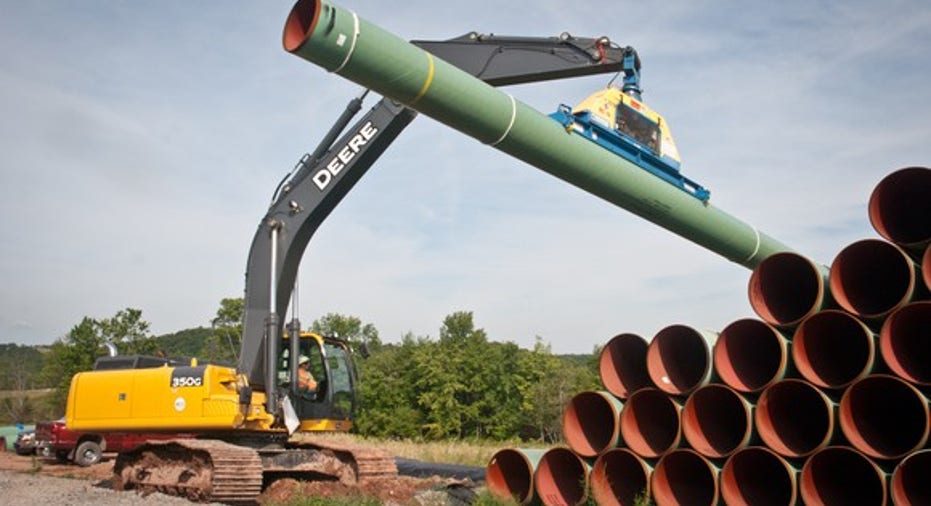Kinder Morgan, Inc.'s Best Moves in 2016

Image source: Kinder Morgan Inc.
Kinder Morgan's (NYSE: KMI) stock crashed in 2015 after a combination of weak oil prices and a tightening credit market forced the company to alter its plans rather dramatically. The company spent this past year working to get back on track, which has resulted in a significant recovery in its stock price since the start of the year. Fueling that rebound was a series of moves that put the company in a much better position to deliver sustainable growth.
Securing financing
One of Kinder Morgan's most pressing problems during the oil market downturn was that it could no longer access the capital markets at favorable rates because of concerns surrounding its leverage. That posed two crucial problems: how would the company finance both expansion projects and upcoming debt maturities? The company solved the first issue in late 2015 by cutting the dividend, which would provide it with more than enough cash to fund expansion capital expenditures internally. Meanwhile, it solved the other in early 2016 by securing bank funding to refinance upcoming debt maturities.
That move came in late January, when the company announced that it had closed a three-year, unsecured $1 billion term loan, as well as a $1 billion expansion of its unsecured credit facility, boosting the borrowing capacity to $5 billion. That term loan provided the company with the liquidity to refinance the bulk of its 2016 long-term debt maturities. Furthermore, it eliminated the company's need to access the capital markets this year, buying more time to address its financial situation. Ideally, the company will be on much stronger financial footing by the time it needs to return to the debt market and refinance this loan.
Purging the backlog
Another problem the company had to address was the presence of more projects in the backlog than it could afford to fund. That is due in part to a decision to sanction some marginal projects that the company initially intended on building, with hopes of improving their economics after they went into service. However, the company realized that this was not the best approach given current market conditions, which is why it decided to pull the plug on two large projects.
One of the projects, the $3.1 billion Northeast Energy Direct pipeline, simply did not have enough customer commitments to make it economically viable. According to CEO Steve Kean: "The return on the NED project at the level of commitments that we have would be less than 6% unlevered after tax. That's clearly not viable, and we are far better off having that cash available for other uses." For comparison, the current average return on projects in the company's backlog is 6.5 times EBITDA for first-year earnings.
Image source: Getty Images.
Securing partners
The company continued to address both its balance sheet and capital funding issues by signing several joint venture agreements. In June, the company announced that private equity firm Riverstone Investment Group agreed to become a 50% partner in the Utopia Pipeline Project. Under the terms of the deal, Riverstone reimbursed Kinder Morgan for a 50% share of the project's costs up to that point and an additional payment in excess of capex to recognize the value created from the project. Furthermore, it would split future costs on the $500 million project going forward.
A few months later, the company signed an even larger strategic joint venture, agreeing to sell a 50% stake in the Southern Natural Gas Pipeline to Southern Company (NYSE: SO) for $1.47 billion in cash plus the assumption of half the system's debt. That cash infusion enabled Kinder Morgan to reduce debt by a significant amount, positioning the company to end the year with 5.3 times debt-to-EBITDA, which was below its 5.5 times year-end target. Furthermore, Southern Company will participate with Kinder Morgan on future growth projects on the pipeline system, sharing capex costs evenly. As a result, this transaction solved two crucial issues because it led to a significant improvement in leverage while supplying the company with a funding partner for future capex on this system.
Investor takeaway
After a tough 2015, Kinder Morgan got to work in 2016 to address the issues that brought it down. Through a series of significant moves, the company secured funding, reduced future capital requirements, and improved its balance sheet. While the company still has some work to do before it can increase the dividend, it is clearly heading in the right direction.
10 stocks we like better than Kinder Morgan When investing geniuses David and Tom Gardner have a stock tip, it can pay to listen. After all, the newsletter they have run for over a decade, Motley Fool Stock Advisor, has tripled the market.*
David and Tom just revealed what they believe are the 10 best stocks for investors to buy right now... and Kinder Morgan wasn't one of them! That's right -- they think these 10 stocks are even better buys.
Click here to learn about these picks!
*Stock Advisor returns as of Nov. 7, 2016
Matt DiLallo owns shares of Kinder Morgan and has the following options: short January 2018 $30 puts on Kinder Morgan and long January 2018 $30 calls on Kinder Morgan. The Motley Fool owns shares of and recommends Kinder Morgan. Try any of our Foolish newsletter services free for 30 days. We Fools may not all hold the same opinions, but we all believe that considering a diverse range of insights makes us better investors. The Motley Fool has a disclosure policy.



















